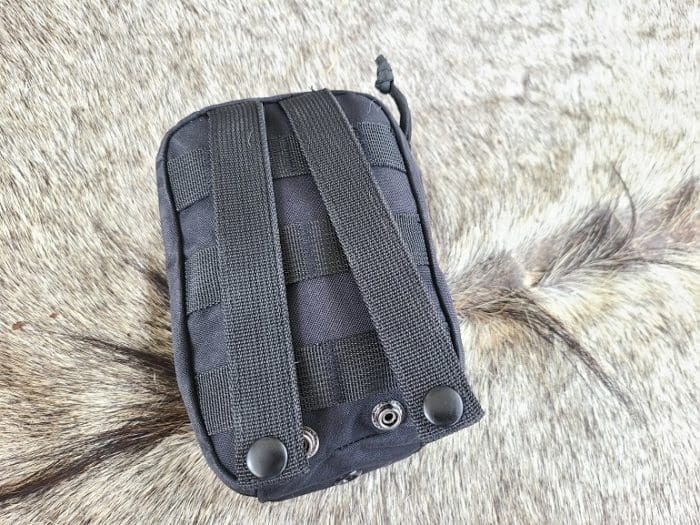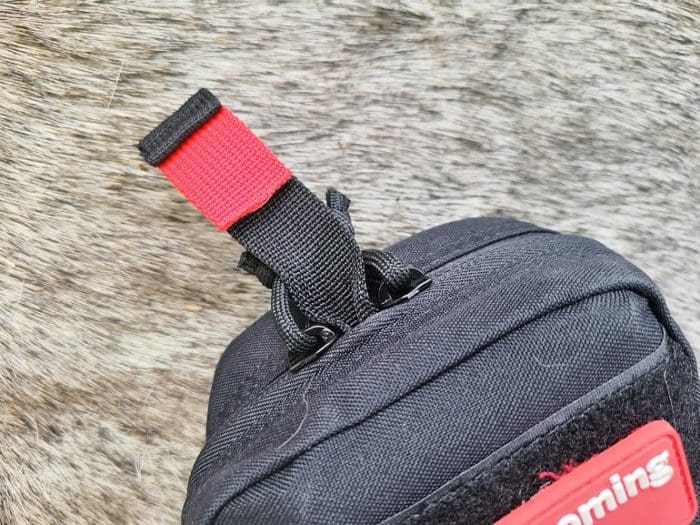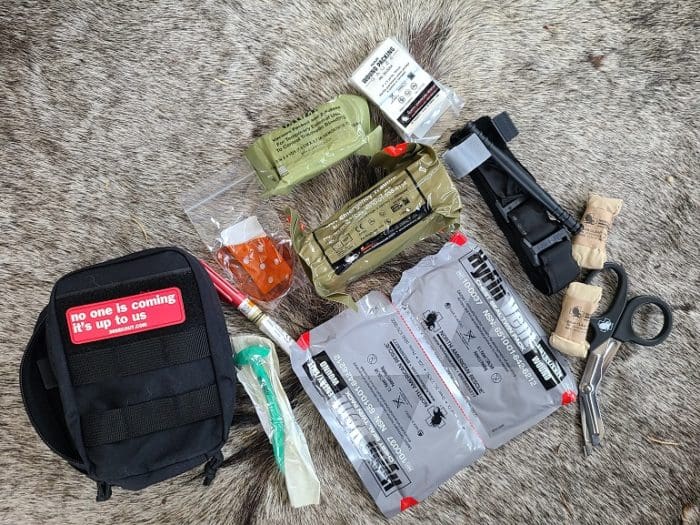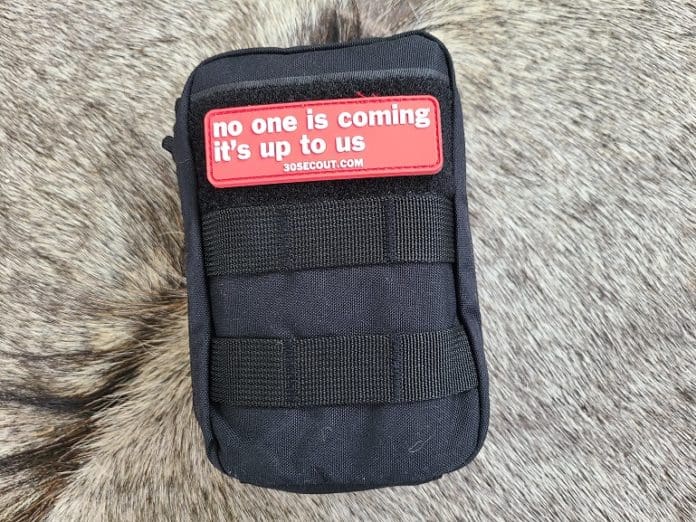If you’re going to buy a basic trauma kit, the North American Rescue Tactical Operator Response Kit (TORK) is a great one. I got this kit from LA Police Gear. This is not my first one. I don’t know how many I have, but it’s more than a few. Between offices, homes, bags, and vehicles, I’ve got them everywhere.
I’ve been an emergency medical professional for some decades now. I’ve done this work in peace and in war, CONUS and OCONUS, volunteer and as employment.
People are always asking me what kit they should buy. I generally tell them to buy a list of things, like what’s suggested in one of my previous articles, and put it in a gallon Ziplock type bag.
I like Ziplock type bags because they’re dirt cheap, small enough to hand to someone who’s helping you, and you can see what’s in them. But they have significant drawbacks.
They are relatively delicate and eventually break, and you can’t attach them to anything. Some kind of holder is helpful, and there’s a few good ones on the market. Hence my collection of TOR Kits.

Anything from North American Rescue (NAR) is bound to be quality. I’ve been using their gear for decades, since they were called North American Rescue Products. They’ve tested and sold quality, research-driven medical and rescue supplies since the late 90’s.
They have some of the best and most experienced remote, emergency, and tactical medical providers in the world on their staff, and I’ve been honored to directly work with a few of them. You often pay a little (and I do mean just a few dollars) more for NAR products, but you know you’re getting reputable, proven gear.

The TORK carrier itself is small and smart. It’s got MOLLE/PALS style connections front and back allowing the user to add to the front or easily attach it to web gear. I don’t think I actually have any of these attached to web gear, but instead straps and door handles on the outsides of other gear and vehicles.

It’s also got a red tipped tab that attached to the bag, so that, if left outside with the zippers closed on either side, all you have to do is pull the tab and that opens the bag fully. That works particularly well if the bag is secured tightly against web gear.
You’ll also find a loop patch for hook-and-loop/Velcro attachment. I like to put a glow-in-the-dark or otherwise very bright patch here, so eyes go right to it.
Inside the bag are the goodies. The LA Police Gear website lists the contents as follows:

2 Large pairs of quality Bear Claw Nitrile Glove
1 Nasopharyngeal Airway 28F with Lubricant
2 HyFin Vent Chest Seals
1 Black C-A-T (Combat Application Tourniquet)
2 S-Rolled Gauze (4.5 in. x 4.1 yd)
1 6 in. Emergency Trauma Dressing
1 set of Trauma Shears (7.25 in.)
That’s not what came in mine. Mine didn’t have 2 packs of S-Rolled Gauze, but instead one pack and a roll of Quick Clot Combat Gauze. It also included an eye shield and a 14g needle for an emergency needle chest decompression.
I don’t know why I got some different things, but what the LA Police Gear website lists is what NAR actually produces. Perhaps I got an old model. If I were most folks, I’d trade that chest decompression needle for more gauze any day (you can never have enough), but I’d want to keep that Quick Clot Combat Gauze.
The Nasopharyngeal airway is OK. I’ve found relatively little use for it as long as my unconscious patient can be placed in the Recovery Position. It does make a good improvised drain, and may be used to assist with a surgical cricothyroidotomy.
What’s really nice is the included trauma shears and the 2 chest seals. With some training and creativity, those can be used for their intended purpose, or used to create several other types of valuable dressings and fasteners.
There are only two things you need to add to this kit.
First is another tourniquet. Sometimes, even the best tourniquet applications aren’t enough. I’ve never seen two tourniquets — when applied right — fail to stop bleeding from an extremity. And often, especially when associated with high falls and high-speed motor vehicle accidents, two or more limbs are injured enough to require a tourniquet.
Next is tape. I prefer cloth medical tape, but nylon or even duct tape will do. I don’t know why it seems that medical kits never include tape, but you need it. Whether it’s securing bandages, making a splint, taking notes, or creating impromptu dressings, tape is invaluable.
If yours doesn’t come with Quick Clot Combat Gauze, I’d throw a small roll in there as well. It will fit if you make it.
Since there’s plenty of webbing on the outside of the pouch, that’s a fine place to attach a roll of tape and one more tourniquet. You can zip-tie an old phone to the outside and clip a small flashlight to it as well.
If you’re looking for an easy, almost-all-the-basics-you-need kit, this is the one I’d buy. Get it, remove the tourniquet from its plastic packaging and put it back in the pack. Put the kit somewhere super obvious. Then get to training.
And keep training.
Specifications: NAR Tactical Operator Response Kit
Dimensions Closed: H 7 in. x W 4.5 in. x D 2.75 in.
Price: $88.98
Rating (out of five stars):
Overall * * * * 1/2
Just add tape and another tourniquet and it’s all you need. Solid kit from a solid company.





NIVCEF GG RRR EEE
I need to get myself one or three of these. Maybe I’ll spend some of the latest “we’re spending your unborn grandchildren’s money” government gimme-dat on it.
We’ve got basic first-aid kits at home, in each vehicle, and in the bug-out/72-hour kit, but nothing that could deal with a truly life-threatening injury. Well, we do have a ton of gauze and lots of medical tape…could put those in the first-aid kits, at least.
I’ve carried one of these, also from LAPG, for the past year.
The name pegs out the Mall Ninja Meter, but this was the type of helpful, factual review that increased my knowledge level of not only the specific product, but also the subject of first aid in general. Thanks!
Hate the name. Like the kit.
Amen!
I know this is a gun blog, but more people are becoming interested in this type of product. With your background I’d like to see you do a comparison of different types/brands of tourniquets.
Don’t much care for TORK, either. I think Direct Operations Logistical Emergency Neutralization Zoner, Negative Encounter Survival Management Insurance Toward Healing , or Just One Neat Emergency Supply would have worked better.
Collect the full set, and you have the Mission Oriented National Kit, Expeditionary Emergency Service
I need one for last train to Clarksville.
I’m a believer.
You showed the kit resting on the pelt of a critter you may have harvested.
Is it safe to assume the critter didn’t get a chance to see if its life could have been saved by such a kit?
(Sorry, the Devil made me do it… 🙂 )
I was just too slow, again… Oh…. Oh the memories. YOU DONT KNOW CUZ YOU WEREN’T THERE MAN!!!!
How do you do the laughing emoji?
“How do you do the laughing emoji?”
A ( is a frown, and a ) is a smile.
Preface with a colon : and you get a smile.
Preface with a semi-colon ; and you get a smirk.
(As far as I’m concerned, that critter ‘was just asking for it’. They’re all asking for it! )
OMG! Tell me it isn’t possum!!!
Possum, where are you?! Are you OK?!
Not bad. If you want to buy a good kit without a lot of hassle this might be the way to go.
I have basically the same stuff PLUS Hemostatic Gauze, a small light, a sharpie pen for tourniquet time, a small note book just because, 3 yds of 1″ gorilla tape pressed flat, and a little Derma-Safe folding razor. My 2nd tourniquet is a SWAT T, mostly because I had one and I thought it might do double duty if I needed to secure a splint. It sounds like a lot of stuff, but the extras don’t take up very much space at all. I think I built mine just a bit cheaper. You can save a few dollars by getting with some buddies and buying in bulk. It is also a big plus for the guys you hang out with to all have similar kits.
That is my trauma kit, I carry another kit in the car with bandaids, tick removers,aspirin ,ice packs and all of the minor injury stuff. I just don’t want to have to dig through all that crap if someone is seriously injured.
I am kind of an old dog, my training was with the M56 field dressing and using the cellophane from a pack of smokes for a chest seal, but I was lucky enough to find a recent veteran combat medic to teach me the correct way to use this stuff. These guys have seen the elephant, and most will share their knowledge if you ask nicely. And yes a properly applied tourniquet is painful, but hey, you gotta train like you fight right?
FINAL WORDS, Whatever you do, Don’t skimp on quality trying to save a buck. Your life may literally depend on the contents of your kit.
“That is my trauma kit, I carry another kit in the car with bandaids, tick removers,aspirin…”
You may want to re-consider the aspirin.
If memory serves, it can act like a blood thinner, impeding clotting…
It does.
There’s some new data out about OTC pain killers for traumatic injuries and the long and short of it is Tylenol is the drug of choice.
C’mon JWT – You know it’s a motrin and 2 Jolly Ranchers.
In cardiac events it is often advised to give aspirin specifically for that reason. You may have non traumatic occasions to respond to.
I had a stroke a year ago and my wife, an M.D., forced an aspirin down me, saving my life. She carries it all of the time now. The hardest part was figuring out the stroke. Apparently, the differential diagnosis between “he’s acting like a jerk” and “Oh, it’s a stroke!” was pretty slim in my case.
Gee Geoff, I am pretty sure I wouldn’t give aspirin to a bleeding trauma victim. I probably wouldn’t worry about removing ticks from someone with a sucking chest wound, and bandaids usually fall short in stemming arterial bleeds. THAT IS WHY I CARRY TWO KITS!! because each of those things and all of the rest of the stuff I carry in it have use in the treatment of minor injuries and illnesses.
BTW I don’t use acetaminophen myself because I worked a case once where a young woman made a sympathy suicide attempt by eating a bunch of tylenol. She later told me that she didn’t think it would really hurt her. She was wrong. Her death from liver failure was slow and painful and she was not considered for a transplant because the ingestion was voluntary. Taken according to directions it is certainly pretty safe, but I don’t use it
So far, Aspirin, Ibuprofen, or Naproxen Sodium seem to be working pretty well.
“Gee Geoff, I am pretty sure I wouldn’t give aspirin to a bleeding trauma victim.”
Then why did you mention it, Edward?
THANKS ON REMINDING US OF NEED FOR AID KIT .
Good stuff, if you sign up for emails from NAR they run promotions periodically. I opted for their vacuum sealed bleeding control kits when they had a 30 percent off sale. Hopefully I wont have to use it ever but a good thing to have around in case I ever do.
A guy was taking a piss and a rattlesnake bit him. “Quick, suck the poison out.”
His friend said, ” Nice knowing you, anything you want me to tell your family ?”
*snicker*… 😉
Snake bites snake.
OR go to: https://www.tacmedsolutions.com/
and get a SOFTW (not plastic tourniquet) and very competitive pricing on kits etc.
As far as basic supplies you should have a pair of trauma shears (they are insanely inexpensive), some gloves (also very inexpensive), a few rolls of gauze (very inexpensive), a couple 6″ trauma dressings (fairly inexpensive), several sterile 4X4’s (I find these very handy & inexpensive), quick clot gauze (if you can stomach the cost), 2 CATs (with metal bars, not plastic! These are the priciest things in the pack), a couple rolls of GOOD cloth medical tape (test it because crappy tape looks very much like good tape). Honestly, I probably used more 4X4’s, gauze rolls and tape than any other item during my time so I put a premium on those.
Two CAT’s and some Quickclot gauze will put you close to $75 then a good bag will put you over $100. Fortunately all the other stuff is pretty inexpensive. One life saved makes it an incredible bargain, especially if it’s a friend or family member.
Basic first aid classes are a great start but they are called basic for a reason. Chances are that any situation where the stuff in your trauma kit like a tourniquet is necessary will be one that requires a significantly higher skill set. IF you have the time and IF you can afford to do it, then I highly recommend going to EMT school. What you learn will put you way ahead of a basic first aid class and will give you a lifetime of knowledge and skills.
See if there’s a fire department near you that uses volunteers. Sometimes they will pay for your EMT school and it’s a great way to practice your skills and help your community at the same time. Either way, get good training and work your way up from the basic first aid course to as experienced as you can afford!
The newest generation plastic bar’d CAT from NAR work just fine in any climate. The old ones could break or get brittle, but the newer ones, from the last couple of years, will last and last. I’ve had some strapped to the outside of a vehicle for well over a year in temperatures that range from freezing to well over 100° and then tested them. They were perfect.
“ระบบออโต้รวดเร็วจบในที่เดียว สมัคร เว็บคาสิโนออนไลน์ อันดับ 1
เว็บคาสิโนที่ดีที่สุด เปิดให้บริการ 24 ชั่วโมง ไม่มีหยุด เล่นได้ไม่มีเบื่อกับเกมที่หลากหลาย คาสิโนส่งตรงจากบ่อน ถ่ายทอดสดแบบเรียลไทม์ ไม่มีกระตุก ภาพสวย คมชัด ด้วยระบบ HD ด้วยระบบฝาก-ถอน Auto รวดเร็วทันใจ ฝาก ถอน เงินเข้าภายใน 10 วินาที”
Comments are closed.